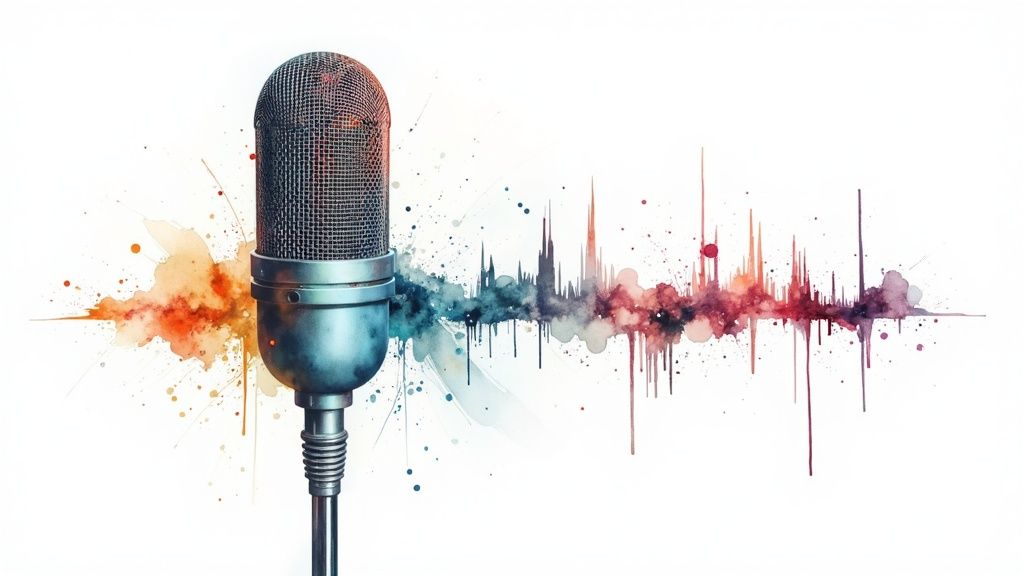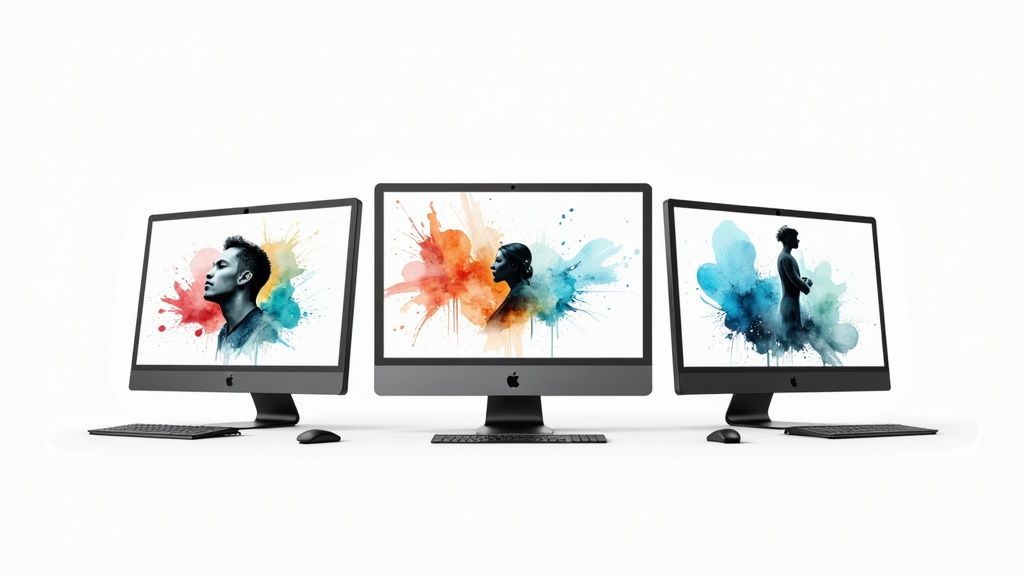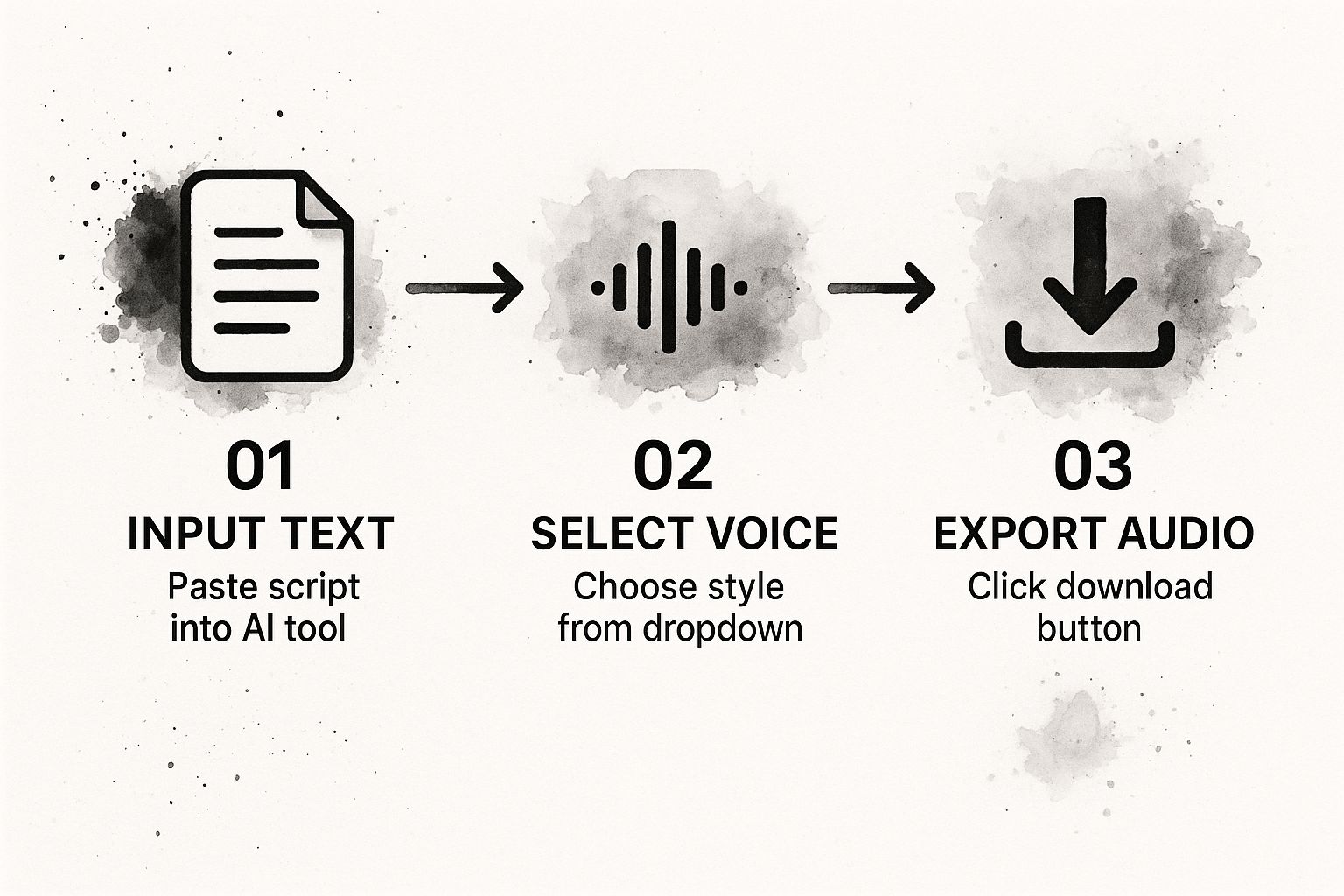
What if you could dream up any sound effect and have it ready to use, for free, in just a few seconds? That’s exactly what a free AI audio generator offers. We’re seeing a major shift as developers, filmmakers, and podcasters leave behind costly, restrictive sound libraries for the creative freedom of making unique, royalty-free audio from a simple text prompt.

For a long time, finding the right sound effect was a real headache. You’d spend hours digging through huge stock audio libraries, trying to find a clip that was close enough to what you actually needed. It was a slow, frustrating process that often came with a hefty price tag and confusing licensing rules that dictated where and how you could even use the sound.
This old way of doing things caused a lot of friction for creators. A filmmaker might need the very specific sound of a rusty wrench scraping against a concrete floor, but the library only has generic "metal scrapes." Or a podcaster might want a signature sound for their show, only to hear that same stock clip on a dozen other podcasts. It's a real creativity killer.
A free AI audio generator turns that entire process on its head. Instead of searching for a sound someone else made, you create a brand-new one from scratch. This puts you, the creator, back in the driver's seat.
Tools like SFX Engine hand you a nearly infinite sound palette. You’re no longer limited by a catalog's inventory; the only boundary is your own imagination. This is why the market is booming. The global AI voice generator market was valued at around $2.07 billion and is expected to climb to $2.49 billion the next year. You can dig into more of the numbers on this growth in a report from The Business Research Company.
The real power here is creating specific, nuanced audio that perfectly fits the mood of your project. It's the difference between buying a suit off the rack and having one custom-tailored just for you.
The difference between sourcing stock sounds and creating your own with AI is stark. One method involves searching and settling, while the other is about creation and customization. Here’s a quick breakdown of how they compare.
| Feature | Traditional Sound Libraries | Free AI Audio Generator (like SFX Engine) |
|---|---|---|
| Uniqueness | Low. Sounds are used by many creators. | High. Every generated sound can be unique. |
| Customization | Very limited or none at all. | Infinite. Tailor sounds with text prompts. |
| Cost | Can be expensive (subscriptions or per-clip fees). | Often has a generous free tier. |
| Licensing | Often complex and restrictive. | Typically simple, royalty-free for commercial use. |
| Time Investment | Hours of searching and auditioning clips. | Seconds or minutes to generate and refine. |
Ultimately, AI audio generators remove the barriers that once stood in the way of high-quality, custom sound design. Whether you’re an indie game dev building an immersive world or a YouTuber who needs unique SFX for your videos, you can now turn a simple idea into professional-grade audio without a big budget or technical skills.
Diving into a new audio tool doesn't have to be complicated. With a free AI audio generator like SFX Engine, you can go from an idea to a finished sound effect in minutes. There's no complex setup—it's all designed to get you creating right away.
When you land on the site, you'll see a clean, uncluttered interface. It’s built for one thing: turning your text descriptions into high-quality audio.
Everything revolves around the prompt box you see in the center. Your available credits and sound history are easy to find, so you always know where you stand.
This text box is where the magic happens. It’s your direct line to the AI. Think of it less like a search bar and more like giving directions to a foley artist. The better your description, the better the sound.
So, instead of just typing "wind," try something more descriptive. Maybe you need "a gentle breeze rustling through dry autumn leaves in a quiet forest." That level of detail is what helps the AI craft a sound that's genuinely unique and perfect for your scene. Don't stress about nailing it on the first go—playing around with different prompts is half the fun.
As you get comfortable with AI audio, it helps to see how it fits into the bigger picture. Understanding the best music production software for beginners can give you a great overview of the other tools that bring a project to life.
The free tier gives you a handful of credits to start experimenting immediately. There's no pressure and no commitment. Just type your idea, hit the generate button, and see what you get.

The real magic behind getting incredible audio from a tool like SFX Engine isn't some hidden trick. It all comes down to the quality of your prompt. If you want to move past generic sounds and create something truly unique, you need to think less like you're searching a database and more like you're directing a foley artist.
Let's walk through a common scenario. Imagine you're working on a fantasy video game or maybe a spooky podcast. You need the sound of a door opening.
A simple prompt like "door creak" will get you... well, a door creak. It'll be functional, sure, but it won't have any character or context. It’s the audio equivalent of a stock photo. To get something that feels authentic and serves your story, you need to feed the AI more detail.
From my experience, the best prompts almost always touch on four key elements. Think of them as the building blocks for a rich audio scene. When you consciously include each one, you give the AI a clear blueprint to work from.
Combining these layers is what separates a decent sound effect from a great one. You're not just asking for a sound; you're asking the AI to build an entire world around that sound.
The goal is to paint a picture with words. AI models are trained on descriptive language, so giving them a vivid scene to interpret directly results in more nuanced and believable audio.
So, let's put all those pieces together. We take our basic idea and infuse it with the details we just outlined.
Instead of "door creak," we give the AI this:
"A heavy wooden door creaking open slowly in a dusty, abandoned castle hall, with a slight echo."
Night and day, right?
This prompt gives the AI everything it needs. It understands the object's weight (heavy), its material (wooden), the precise action (creaking open slowly), and the acoustic properties of the space (dusty, abandoned castle hall, with a slight echo). The sound you get back will have depth, atmosphere, and a professional quality that a generic clip from a stock library could never compete with. This is the kind of control that truly makes these tools a game-changer for creators.
So, you've gotten the hang of basic prompts. Now it's time to really dig in and learn how to coax incredible sounds from the AI. The truth is, the quality of the audio you generate is a direct reflection of the detail you provide. To get truly remarkable results, you need to think less like a technician and more like a storyteller.
Using evocative language is the secret sauce here. Instead of just describing an action, try painting a picture with your words. A simple "footstep" is okay, but it's generic. Think about the difference between a "squishy footstep in wet mud" and a "brittle footstep on dry leaves." See how much more information those descriptive words give the AI? You’re providing crucial details about texture, environment, and context.
This same idea works wonders when you're describing materials. A prompt for "fabric tearing" is pretty vague. But if you specify "heavy canvas tearing forcefully," you'll get something completely different from "thin silk ripping gently." That level of detail eliminates the guesswork for the AI and gives you a much more precise sound.
Another pro-level technique is to add atmospheric context. Consider "wind blowing" versus "a lonely wind howling across a frozen tundra." The second prompt doesn't just describe a sound; it adds emotion and a sense of place. The result is a sound effect with far more character and depth.
This simple workflow—typing in your idea, refining it, and generating the audio—is what makes tools like SFX Engine so powerful for creators.

As you can see, it only takes a few steps to go from a simple text prompt to a ready-to-use audio file. It’s incredibly efficient. If you want to explore even more strategies for writing effective prompts, our complete AI sound effect generator guide is the perfect next step.
Pro Tip: Don't shy away from using emotional or abstract language. I've found that prompts like "a sad, dripping faucet in an empty room" can often produce surprisingly useful and evocative results that a purely technical description would completely miss. Experimentation is your best friend.

Alright, you've gone through the process and created some fantastic, one-of-a-kind sounds. Now for the fun part: actually using them. This is where your creativity really takes over. Having a library of custom, royalty-free audio gives you a massive advantage over relying on the same old generic stock sounds everyone else uses.
A unique sound can do more than just fill a silent moment; it can become a core part of your brand identity, making your work instantly recognizable. It's a subtle but powerful way to stand out.
The possibilities are pretty much endless, but let's break down a few real-world examples to get your ideas flowing.
The real power move is combining this custom audio with other AI tools. For instance, pairing your sound effects with an AI-generated voiceover can dramatically improve storytelling on platforms like YouTube and TikTok.
If you're branching out into performance-based content, you could even explore the best AI karaoke video maker to see how custom sounds can enhance sing-along videos.
And if you ever hit a creative wall and need some inspiration, you can always browse our huge library of royalty-free sound effects to spark new ideas. At the end of the day, integrating these unique sounds adds a layer of professionalism and personality that truly sets your work apart.
As you start playing with AI to create audio, a few questions are bound to come up. It's totally normal. Getting straight answers helps you dive in with confidence, so you know you're using these powerful tools the right way. Let's walk through some of the big ones.
For the most part, yes. One of the biggest perks of using a free AI audio generator like SFX Engine is that the sounds you make are almost always royalty-free. That means you can drop them into your YouTube videos, indie games, or podcasts without worrying about ongoing fees.
That said, I always recommend taking a quick look at the terms of service for any platform you use. It's a smart habit that takes just a few minutes and ensures you're completely in the clear for your specific project.
Free plans are awesome for getting your feet wet, but they do have some guardrails. You'll typically run into a few common limits:
For most creators just starting out, these free plans offer more than enough juice. But if you're a pro who needs a massive volume of sounds, unlimited access, and extra features, an upgrade is usually a solid investment. You can see how different plans compare in our breakdown of the best AI sound effect generators in 2024.
You bet. The audio files you download—often in high-quality formats like WAV—are yours to tweak and perfect. You can import them straight into your favorite Digital Audio Workstation (DAW), whether that's Audacity, Adobe Audition, or Logic Pro.
I like to think of AI-generated audio as a high-quality raw ingredient. You can chop it up, layer it with other effects, add some reverb or compression, and mix it perfectly into your project's soundscape.
This flexibility turns a simple generated sound into a powerful starting point for really polished and complex sound design. And while we're focused on sound effects here, it's worth noting how AI is shaking up other areas, too, like with AI-powered voice typing in Microsoft Outlook).
Ready to stop searching and start creating? Sign up for SFX Engine today and get free credits to generate your first custom, royalty-free sound effect in seconds. Experience the future of sound design at SFX Engine.
Article created using Outrank